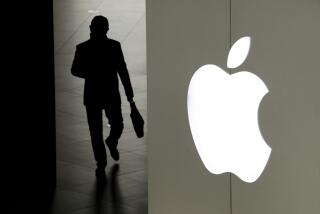Patents Not at Core of Apple Suit
- Share via
Apple Computer dropped a bombshell on the personal computer industry last week by suing Microsoft and Hewlett-Packard. The suit alleges that Microsoft Windows (version 2.03) and Hewlett-Packard’s NewWave software infringe on copyrights that Apple holds for the way its Macintosh computer displays information on a video screen.
Although Windows and NewWave enable IBM-style machines to look and behave somewhat like a Macintosh, they do not turn IBM PCs into Macintosh clones. Rather, they make the PC easier to use by incorporating on-screen graphics and the use of a hand-held device called a mouse to issue commands and manipulate information. That style of computing, known as a graphical user interface, is becoming an industry trend.
Apple clearly doesn’t have exclusive rights for such a format. While some elements of the Macintosh’s screen and commands were developed by Apple, the original research that led to the graphical interface came from Xerox’s Palo Alto Research Center, which, during the 1970s, studied ways to improve the way people communicate with computers. Several companies, including Xerox, Sun and Apollo, employed this sort of format before it was adopted by Apple. The Atari ST and Commodore Amiga personal computers, introduced after the Macintosh, also employ what has become known as a “Mac-like” look.
The industry’s move to the new style of computing is now a big issue because IBM has indicated that a coming version of its new OS/2 operating system will include an optional graphic interface, called Presentation Manager, that will closely resemble Microsoft Windows. Both Windows and Presentation Manager will allow more than one program to run at a time, each in its own window, or section, of the screen.
Most industry insiders say that the suit is aimed more at OS/2, which is being developed by Microsoft with IBM, than at Windows or NewWave. OS/2 will run on high-end IBM style machines from IBM, Compaq and Tandy, among others. With the number of IBM-compatible computers estimated to outnumber the Macintosh 10 to 1, software companies have a strong incentive to write programs for OS/2. To make matters worse for Apple, many of the companies that make Macintosh software are developing similar programs to run under OS/2’s Presentation Manager.
The availability of feature-rich and easy-to-use software has been a major factor in Apple’s recent success. If equally good programs become available for IBM-compatible machines, Apple stands to lose business, especially because of the relatively high prices for Apple’s Macintosh.
So far, there are few programs that work with Windows. Software must be designed specifically to work with it. The most popular Windows programs are Excel, a spreadsheet from Microsoft, and PageMaker, a desktop publishing program from Aldus. First available on the Apple Macintosh, both remain best sellers among Mac users.
To compare the look of the Mac with that of Windows, I ran Windows 2.03 on an IBM compatible machine while simultaneously using a Macintosh II running MultiFinder, the version of Apple’s operating system that makes it possible to run several programs at a time. I was not able to obtain a copy of NewWave, but I have seen the product in operation and have studied photos of NewWave’s screen that Hewlett-Packard provided several months ago.
Although Windows and the Macintosh have some similarities, their displays do not have the same appearance and there are significant differences in the way users enter commands. NewWave looks more like the Mac but offers additional features.
Here are some examples of how the “look and feel” of Macintosh, Windows and NewWave compare:
- The Macintosh can display files as “icons,” or graphic images, as does NewWave. Windows, as it comes from Microsoft, displays files only by their names.
- The Macintosh Finder (the display you see when you start the machine) has four main menus--File, Edit, View and Special. Windows has three such menus--File, View and Special--and some of the menu options differ. NewWave has seven main menus.
- The systems use different methods for changing the size of windows, a maneuver used to control how many programs can appear on the screen at a time. Mac users point to a small box, and then indicate with the click of the mouse when to reduce or enlarge the window. Windows and NewWave employ up and down arrows instead, and each has a third arrow to temporarily remove a program from the main display, freeing the entire display for another program. That’s not only different from the Mac, it’s a lot better. The Macintosh’s windows are difficult to hide and tend to clutter the screen.
- Macintosh users erase files by dragging the icon or file name into a “trash can.” With Windows, you use the mouse to highlight the file’s name and select “erase” from a menu. NewWave, however, uses a “waste basket” that looks similar to Apple’s trash can.
To demonstrate its claim against Hewlett-Packard, Apple provided the media with a photograph showing both a Mac and a NewWave screen with windows, icons and the trash receptacles in the same location. A photograph that Hewlett-Packard provided several months ago shows a different set-up. That’s because the actual arrangement of the icons, on NewWave and the Mac, can be controlled by the user.
Hewlett-Packard claimed the NewWave screen was rearranged to more closely resemble the Mac in Apple’s pictures, but Apple denied the charge.
In any case, the offending icons represent broad concepts, not Apple trademarks.
Although Apple has a right to protect the results of its development and marketing efforts, it should not try to thwart the obvious direction of the entire industry. Apple deserves a lot of credit for developing the Macintosh, but it does not own a patent on ease of use or the right to use graphics.
Regardless of the suit’s outcome, the computer industry increasingly will use something along the lines of the graphical user interface that now makes Apple distinctive. Instead of fighting its competition in court, Apple should cut its prices and keep developing innovative products.
Computer File welcomes readers’ comments but regrets that the authors cannot respond individually to letters. Write to Lawrence J. Magid, 3235 Kifer Road, Suite 100, Santa Clara, Calif. 95051, or contact the L. Magid account on the MCI electronic mail system.
More to Read
Inside the business of entertainment
The Wide Shot brings you news, analysis and insights on everything from streaming wars to production — and what it all means for the future.
You may occasionally receive promotional content from the Los Angeles Times.








